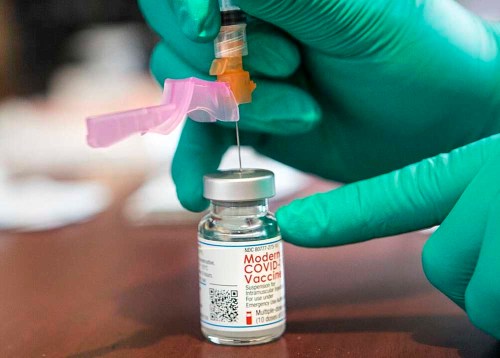Biden, Brown shift vaccine doses to where demand is high
Published 8:00 am Thursday, May 6, 2021

- Kerry Gillette, a physician assistant with Mosaic Medical, fills syringes with the Moderna vaccine during a COVID-19 vaccination clinic at Bethlehem Inn in Bend on Friday, Feb. 19, 2021.
SALEM — Hoping to pick up the pace of vaccinations, state and federal health officials are ditching their population-based distribution game plans to get more doses where they are wanted and needed.
President Joe Biden wants 70% of American adults fully vaccinated by the Fourth of July. The goal translates to about 160 million people. Currently, 105 million American adults are fully vaccinated.
Trending
To get there, Biden announced Tuesday, May 4, that he was ending the system that sent weekly shipments of vaccine to states in amounts based on their population.
The move will send more vaccine to places where demand is high, with additional supply drawn from areas where vaccine sits unused in medical refrigerators.
Allotments to states that do not want or cannot use more vaccine will go into a federal “vaccine bank.” States where shots are in demand will be able to order up to 50% more than their current allotments.
Oregon, California and Michigan are among states saying they still need more vaccine to meet demand. On the flip side, West Virginia has reported a surplus of vaccine and Arkansas officials said the state no longer wants weekly shipments.
With Oregon one of 12 states currently seeing an increase in COVID-19 cases, the state plans to withdraw from the vaccine bank quickly.
“Oregon will ask for the maximum allowed, which will help us to get shots in arms faster,” Gov. Kate Brown said May 4.
Trending
Oregon is scheduled to receive 848,840 doses of Pfizer and Moderna vaccine, which requires two shots to fully vaccinate. The state is receiving an additional 7,300 Johnson & Johnson single-shot doses. A 50 percent increase in total doses would give the state over 1.27 million doses in a delivery.
On April 27, Oregon’s infection rate had grown by 53% over the previous two weeks, the highest mark in the nation.
COVID-19 infections are still rising in Oregon, but more slowly. Cases have risen only 12% over the past two weeks. Oregon’s 33% increase in hospitalizations over the same time is the third highest in the nation, behind only Alaska and Kansas.
Nationwide, the infection rate is down 26% in the past two weeks.
A positive trend is a decline in deaths from the virus. OHA reported 55 COVID-19 fatalities in April, the lowest total since 22 died in March 2020, early in the pandemic. December 2020 was the worst month, with 597 deaths.
OHA data suggests that the leading cause of the lower fatality rate was the number of older people and those with underlying medical conditions who have been vaccinated.
A key part was inoculations of patients and staff in nursing homes, which are tied to 53% of all COVID-19 deaths in Oregon. The nation average is 32%.
Oregon currently has the fifth lowest death rate per 100,000 people in the United States. Alaska, Vermont, Hawaii and Idaho have lower rates.
Biden’s vaccination goal would require that 55 million people get their first shot by the end of the first week of June, just four weeks from now.
The Oregon Health Authority reported May 6 that just under 37% of state residents age 16 and older were fully vaccinated. Another 15% have had one shot and have scheduled their second dose.
The one-shot Johnson & Johnson vaccine could speed up the effort, but manufacturing issues and a review of safety concerns have slowed distribution to a trickle.
Just as there are states that eagerly desire the vaccine while others shun it, counties in Oregon show the same pattern.
The percentage of adults who had received at least one vaccine shot varied widely across Oregon’s 36 counties, from 64% in Benton and Hood River counties, to just over 32% in Lake, Umatilla, and Malheur counties.
That’s led to shifting more vaccine to areas where it is in demand, including Portland.
Umatilla County Commissioner George Murdock told the East Oregonian newspaper that some of the reasons for the low turnout to get shots were political.
Though ex-President Donald Trump was vaccinated, some see vaccination refusal as an extension of the opposition to Brown’s orders closing businesses that angered many in the area.
“The polling seems to show older Republican men seem to be the group who least likely want to get the vaccination,” Murdock said. “But I’m an absolute contrast to that. I’m old, I’m a Republican and I couldn’t wait to get mine fast enough.”
Oregon has the highest rate of “vaccine hesitancy” on the West Coast, with 15% of residents saying they are unsure or don’t want to get the shots, according to a report this week from the Centers for Disease Control and Prevention.
In contrast, California and Washington are reporting about 11% of the population is unsure or doesn’t want to be inoculated. California officials said the highest rates of negative response were in the northern tier of rural counties nearest the Oregon border.
Oregon has also dealt with what OHA Director Pat Allen has called “vaccine belligerency,” an active opposition to not only being inoculated, but at times protesting those who choose to get the vaccine. Incidents have included the heckling by anti-vaccination hardliners of Bend high school students at a school-sponsored clinic.
Other steps are being taken to get more “impulse vaccinations” by offering shots without appointments. Many people across the country and in Oregon have expressed frustration with multiple, sometimes clunky websites required to make appointments. Now, it’s possible to just show up and roll up a sleeve.
“The Oregon Convention Center is offering walk-in vaccinations starting Friday,” said Charles Boyle, a Brown spokesman.
Both federal and state health officials have said that they will also increasingly find ways to get vaccine to people instead of people to the vaccine. This will include mobile clinics, pop-up sites and vaccination days at major employers.
Over the entire pandemic that began in China on Dec. 31, 2019, Oregon has had the third lowest per capita number of cases in the nation, at 4,432 per 100,000.
Though the recent rise in infections has been sharp, Oregon’s longstanding place near the bottom of cases and deaths means that its per capita number of cases pushed it no higher than 12th place.
Oregon was among about a half dozen states with the lowest infection and death rates over the course of the pandemic. Just over 2,500 deaths were reported by Oregon out of the more than 575,000 deaths in the United States.
There is currently no vaccine approved for children. Pfizer announced it will ask for federal approval for emergency use of its vaccine on children as young as 2. The company told Wall Street analysts during an earnings call that the approval could come as early as next week.









